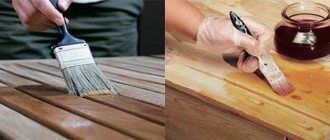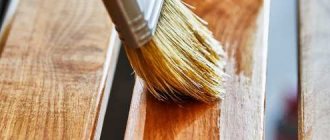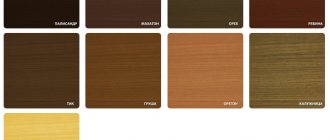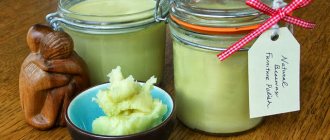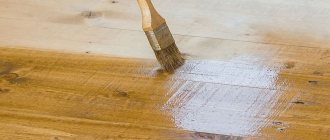Wood must be protected, not only for aesthetic reasons, but also for durability. There are several ways to protect your products from fungus, mold, sun, moisture and insects - by painting with covering paints or using wood oil for exterior work. Another method is constructive protection, when the structure itself ensures that the wood will not be exposed to such amounts of precipitation and other harmful effects of the atmosphere.
Why is it necessary to create a protective barrier?
Sun - if the external structure is not treated and protected, then Ultra Violet rays destroy the surface outside, making it gray, dry, faded. Subsequently, wood that is too dry begins to crack and loses its strength, which leads to destruction, separation of fibers, and brittleness.
Moisture is the worst enemy for wood. Rain, snow, condensation - all this is a favorable environment for the growth of harmful microflora. Due to high humidity, growths of moss, mold and various fungi are formed, which can infect not only the surface, but can penetrate deep into the base, making it flabby and loose, which leads to adverse consequences and destruction.
Some structures, decks and other joinery can be left untreated with wood oil outdoors for many years without damage, as they are inherently strong and have a particularly strong structure associated with the species. But unfortunately, nothing is immune from the harmful effects of Ultra Violet - the design simply fades and fades over time, losing its aesthetic appeal and brightness.
What can it be applied to?
Oil-based preservatives can be used to protect common and exotic (mostly hardwood) wood indoors and outdoors.
In rooms, they are most often chosen to protect wooden floors and stairs.
- Manufacturers offer special mixtures called parquet oils, wood floor oils or stair oils.
- Special wood oils can also be successfully used to care for wooden countertops in kitchens or bathrooms (countertop oils), as well as to protect wooden furniture (furniture oils).
However, as mentioned above, before purchasing, you should ask about how toxic these oils are. It is better not to risk your health and choose the least harmful option.
Gnature (Germany)
Another German company specializing in natural materials for the protective treatment of wood surfaces. The products contain natural ingredients: linseed, castor, safflower and wood oils, rosin, hard and soft waxes, kaolin, thermally treated resins.
The assortment includes protective primer oils, glazing and covering materials for:
- wooden floors, parquet, cork and stairs;
- countertops and furniture (with a high wax content);
- walls and ceilings;
- terraces and decking;
- facades, fences, doors and windows.
The coatings are colorless, tinted according to the catalogue. The line contains organic and completely natural products with zero VOC content. Thanks to a specially selected composition, facade paints are resistant to fading: the company guarantees color retention after Fassadenöl treatment for 10 years.
| Product/Features | Usage | Consumption 1 l/m2 | Drying, 1 sheet/hour | Coating | Smell |
| Hartwachsol | wear-resistant floor oil | 16-20 | 12-16 | matte | light oily |
| Bienenwachslasur | water glaze for walls in rooms | 13-17 | 12-16 | matte shine | No |
| Mobelöl | for furniture and application in 1 layer | 40-50 | 16-24 | silky matte or silky | practically absent |
| Terrassenol | with UV filters for decking boards | 16-20 | 16-24 | matte shine | easy |
| Fassadenol | with UV and bioprotection for facades | 18-Oct | 16-24 | matte | easy |
How does wood oil work?
Wood oil applied to its surface penetrates to a certain depth into the structure of this material. In most cases, organic solvent-based oil shows better permeability than water-based oil, which is important. Organic oil particles envelop all wood elements.
Since they themselves are water-repellent, they prevent moisture from coming into contact with the wood and also promote evaporation.
conclusions
In the products of each manufacturer you can find compositions that will protect, decorate or renew surfaces in the home and outdoors. We present the final table of manufacturers, where you will find information on the average consumption of products, price, coating characteristics and the presence of wax in the composition.
| Brand/Features | Ruler | Average consumption, m2 | Price per liter, rub. | Coating | Wax included |
| Borma Wachs | wide | 8-16 | ≈ 2000 | colored and colorless, up to 18 colors | There is |
| Saicos | wide | 15 | from 700 to 3000 | colorless and colored, up to 23 colors | There is |
| Biofa | wide for interior | 10-15 | from 2000 to 3500 | colorless base, tinted | There is |
| Rustins | narrow | 12-14, application in 3 layers | from 2500 | colorless and three natural shades | No |
| Rubio Monocoat | three products | 30-50, treatment in 1 layer | from 8000 | colorless and colored, from 40 colors | There is |
| Tikkurila | wide for outdoor use | 7-10 | up to 1300 | colorless base, up to 40 shades | No |
| Gnature | wide | 15-20 | ≈ 2000 for 0.75 l | colorless, tinted | There is |
| Pinotex | one product | 20, processing in 3 layers | ≈ 2300 | teak, tinted in 50 shades | wax additive |
| Remmers | wide | 15 | from 1500 to 3000 | colorless and colored in natural shades | There is |
| Osmo | wide | 24 | from 3700 | clear and colored, 24 ready-made colors and tinting in 2000 shades | There is |
Please note that there are products that can be used for different purposes - for tinting, priming and finishing. This allows you to save on surface preparation and reduce processing time.
Some companies pay more attention to protection, others to the decorative effect, and still others try to satisfy all needs with one product. When choosing the best oil for wood, you need to take into account the composition, decorative capabilities, consumption, price and, of course, the tasks facing you.
Wood oil base
Wood oils can be based on organic solvents or water.
- Oils based on organic solvents penetrate the wood structure much better, providing longer-lasting protection. However, the solvents themselves are very toxic, volatile and flammable, so their use is currently limited, although they are more effective.
- Water-based oils do not penetrate wood well, so they are used to lubricate the hardest types of wood and elements that will not be subjected to too intense use. The advantage of water-based oils is that they are (relatively) non-toxic and that they do not leave a distinctive odor.
Why do you need to process wood?
Wood of any species has high hydrophilic characteristics. Wood absorbs moisture literally from everywhere: from the atmosphere, soil, precipitation. In summer it is exposed to active sun and insect pests. In the autumn-winter period, the condition of a wooden house is negatively affected by temperature changes.
Unprotected wood cannot withstand such pressure for a long time and gradually destructive processes begin to occur in it. Special compounds have been developed to protect wood. These are all kinds of antiseptic impregnations, varnishes, paints, oils, waxes, the use of which allows you to protect a wooden house from the harmful effects of the environment.
In this review, we will touch on only one group of protective and decorative products – oils for wood processing.
Wood oil color
- The basic option is to use colorless oils. They usually increase the contrast of the wood grain a little or make it a few shades darker, but usually the color doesn't change. Clear wood oil is used primarily for repairs, but also to protect and enhance the natural beauty of wood.
- Wood oil with paint has the same protective properties as the colorless version, but it contains pigments, thanks to which the wood can be tinted. The peculiarity of these colors is that colored varnishes are always chosen that are darker than the original color.
- Wood lightening oil complements the aesthetic possibilities. It is used relatively rarely and, above all, in repair work to restore the original appearance of wood. Lightening is an effect achieved thanks to aggressive compounds, so in their case you need to be especially careful and take care of the surrounding space when applying a protective layer.
Processing a wooden house inside
The application of the oil composition is carried out in the warm season in the presence of good ventilation of the premises. Apply the oil to the interior surfaces of the house using a soft brush or microfiber roller. The composition is distributed evenly over the entire surface; in hard-to-reach places and corners, use a thin brush. Excess oil is removed using a dry, lint-free cloth. After the first layer has dried, begin applying the second protective oil layer in a similar way. Complete drying of the treated surface requires about 10 days, the exact period depends on the level of ventilation and the viscosity of the composition. Indoor walls can be given the most attractive appearance by finishing oiled wood with a soft cloth.
Oil or varnish
Oils are often presented as an alternative to varnishes, but in reality they are not completely interchangeable. Varnishes primarily protect the surface and penetrate relatively poorly into the wood structure, creating a strong, durable layer on the surface, while oils penetrate deeper, but if the wood is worn away, the protection disappears.
In general, varnish works better on surfaces that experience a lot of wear or on softwood items, while oils are used on hardwoods.
This rule always applies - oils for exotic wood are no different from oils for local species, because the structure of the wood itself is exactly the same.
Benefits of oils
Advantages of oil for treating garden furniture:
- The product, penetrating into the pores, restores the structure and preserves it in the future. The furniture looks natural.
- Water repellents prevent fungus from developing.
- Preservation of furniture in its original form for a long time.
Terrace with a swimming pool, impregnated with oil
Oil impregnates the furniture, therefore it is resistant to abrasion.
Oil wax
An interesting means for impregnating and caring for wood is oil-wax. Made from vegetable oils and beeswax, it is a natural preservative for wooden furniture, floors and structural elements.
Thanks to its dual composition, the wood is well protected from moisture, dryness, and sunlight. And by adding wax, protection against mechanical damage and scratches is provided (at least, that’s what the manufacturers say).
Oil wax is a universal product. It can be used to care for wooden floors (including terrace floors), as well as furniture and wooden elements in the garden.
Impregnation of country products
Oil for garden furniture is selected based on its composition. There must be a UV filter. If you choose a composition with wax, then you should know in advance that after drying the surface becomes slippery.
Application of Aquatex impregnation
The most common is aquatex. Its differences:
- environmental friendliness - contains only natural materials;
- product based on natural wax, it provides additional protection;
- UV filters protect against fading;
- contains an antiseptic;
- absorbs well.
Impregnation for wooden surfaces in the country
Wooden products are processed using 2 methods:
- Soaking – suitable for impregnating small parts.
- Coating.
Impregnation is carried out in stages:
- Preparation. If the furniture is new, it should be sanded. But if the furniture is old, a layer of paint and varnish is removed from it. This is done using a hair dryer (heat) or an iron brush and spatula.
- Sanding stage. It is carried out with sandpaper. The surface should become smooth.
- The entire surface is cleaned of dust using a soft brush.
What oil and how to coat a wooden surface is shown in the video.
Oiling process. It is applied to the surface either with a soft cloth or a brush with natural bristles. After impregnation, the product is left for 20 minutes, then all excess is removed. After complete drying, the oiling procedure is repeated.
Attention. In addition to the pure solution, there is also white oil with natural wax. The properties are almost the same, but the drying speed is faster.
What else you need to remember
- Most oiled finishes will wear off over time. To renew them, the wood layer should be sanded to the thickness of the previous penetration and new oil should be applied. This is not an ideal solution, but it is the only one - you cannot apply new oil on top of the old one.
- When purchasing oil, be sure to read the safety data sheet. Some oils are designed for hardwoods, but there are also those that have been fortified by manufacturers to better protect softwoods. The passport will also contain information about the effectiveness and method of application, which will greatly simplify working with the oil.
- Before purchasing, it is also worth checking whether the oil is suitable for external use. Deck oil is used to protect against various weather conditions (as opposed to oil intended to impregnate the wood inside) and has a high level of moisture resistance.
- Oils should not be used after the expiration date. The structure of some of the components that make up the oil may have already deteriorated, which means that the color and degree of protection will no longer be as good as they were originally.
Pros and cons of painting
It is recommended to paint furniture if you decide to give the products a richer shade. Also, the painting option is suitable for old tables, chairs, beds - this way you can restore their attractive appearance. Paint will protect the wood from precipitation, atmospheric factors and the sun, but you only need to purchase special products. Good quality paint is the key to its even distribution, quick drying and long service life.
The disadvantages include the need for regular touch-ups or a complete change of coating, because sooner or later it will begin to peel off. Paint eliminates the feeling of naturalness, and the products will not look so harmonious.
Before painting, you must use impregnation; this is a prerequisite if the furniture has never been painted. Pre-treatment is done with sandpaper, but not rough. After soaking, moisture will not penetrate into the pores, and the furniture will not swell. If there is an antiseptic in the composition, the impregnation will help prevent the appearance of mold.
After applying the product, wait until it dries completely, then paint the objects in one layer. Next, sanding is performed again to remove the remaining “lint” - it appears as the coloring progresses. Then another layer of paint is applied and, if necessary, the products are varnished. Here are important tips for working:
- do not forget about processing the ends;
- do not work in rain, heat or extreme cold;
- for large areas, painting can be done with a spray gun;
- do not apply more than 3 layers, otherwise they will crack;
- Each layer of paint should be thin.


